| Listing 1 - 10 of 64 | << page >> |
Sort by
|
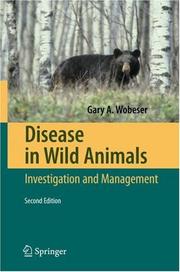
ISBN: 9783540489740 9783540489788 Year: 2007 Publisher: Berlin Springer
Abstract | Keywords | Export | Availability | Bookmark
 Loading...
Loading...Choose an application
- Reference Manager
- EndNote
- RefWorks (Direct export to RefWorks)
Wildlife diseases have become increasingly important recently due to their effect upon human health, veterinary medicine, wildlife, and conservation biology. Gary Wobeser's successful book from 1994 has been completely updated and enlarged in a new second edition. An in-depth overview of the available techniques for the investigation and management of disease in free-ranging animals is provided. The subjects are illustrated with examples drawn from around the world, with emphasis on the special requirements involved in working with wild animals. Techniques are assessed critically with regard to their efficacy and effectiveness. The book draws on the author's training as a wildlife biologist and veterinarian and his experience over four decades with wildlife disease. From the reviews of the first edition "... has done an admirable job of outlining the problems associated with diagnosing and controlling disease in wildlife populations. ... The author has commendably presented a difficult topic and has shown that the usually successful approach to treating disease in domestic animals is extremely difficult and rarely successful in wildlife populations. ... I recommend this book to all who are looking for an introduction to the investigation and managment of disease in wildlife." (Canadian Veterinary Journal)"... the author has made a major contribution to the field by providing a conceptual framework for wildlife disease investigations and by highlighting the inadequacies that often exist. His willingness to challenge dogma and constructively present perspectives based on a combination of extensive literature review, personal experiences, and beliefs is one of the values of this well organized and easy to read publication. ... this publication should be read by biologists, administrators, and disease specialists having responsibility for combatting disease in populations of free-living wildlife." (Journal of Wildlife Diseases)
Wildlife diseases --- Wild animal diseases --- Animals --- Diseases --- Animal Diseases. --- Animals, Wild. --- Animal Diseases --- Animals, Wild
Book
ISBN: 906348139X Year: 1998 Publisher: Maarssen Elsevier/Bunge
Abstract | Keywords | Export | Availability | Bookmark
 Loading...
Loading...Choose an application
- Reference Manager
- EndNote
- RefWorks (Direct export to RefWorks)
Animals --- Laboratory. --- Animal husbandry --- Proefdierkunde --- Vivisectie
Book
ISBN: 9789048136506 9789048136490 Year: 2010 Publisher: s.l. : Springer science & Business media
Abstract | Keywords | Export | Availability | Bookmark
 Loading...
Loading...Choose an application
- Reference Manager
- EndNote
- RefWorks (Direct export to RefWorks)
Describes the welfare implications of keeping wild and domestic birds in captivity. The environmental and social requirements of various avian species are discussed and suggestions made for appropriate housing and management techniques. Particular attention is paid to human-bird interactions and their impact on the behavior and welfare of the birds involved. Training methods for companion birds are also described. Possible future trends in keeping birds in captivity are discussed in relation to evolving laws and codes for both wild and domesticated birds and in the light of developing attitudes to animals.
Life Sciences. --- Zoology. --- Animal Genetics and Genomics. --- Animal Physiology. --- Behavioural Sciences. --- Veterinary Medicine. --- Life sciences. --- Veterinary medicine. --- Animal behavior. --- Animal genetics. --- Sciences de la vie --- Médecine vétérinaire --- Animaux --- Zoologie --- Génétique animale --- Moeurs et comportement --- 590.2 --- dierenwelzijn (lt) --- vogels (lt) --- Animal welfare --- Aviculture --- Bird culture --- Birds --- Culture, Bird --- Rearing of birds --- Animal culture --- Abuse of animals --- Animal cruelty --- Animals --- Animals, Cruelty to --- Animals, Protection of --- Animals, Treatment of --- Cruelty to animals --- Humane treatment of animals --- Kindness to animals --- Mistreatment of animals --- Neglect of animals --- Prevention of cruelty to animals --- Protection of animals --- Treatment of animals --- Welfare, Animal --- Culture --- Husbandry --- Rearing --- Abuse of --- Social aspects
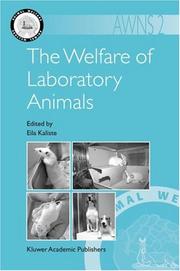
ISBN: 9781402022708 1402022700 9781402022715 9781402061363 1402061366 9786610852390 1280852399 1402022719 Year: 2004 Volume: 2 Publisher: Dordrecht : Springer Netherlands : Imprint: Springer,
Abstract | Keywords | Export | Availability | Bookmark
 Loading...
Loading...Choose an application
- Reference Manager
- EndNote
- RefWorks (Direct export to RefWorks)
Animal welfare is attracting increasing interest worldwide, but particularly from those in developed countries, who now have the knowledge and resources to be able to offer the b est management systems for their farm animals, as well as potentially being able to offer plentiful resources for companion, zoo and laboratory animals. The increased attention given to animal welfare in the West derives la rgely from the fact that the relentless pursuit of financial reward and efficiency has lead to the development of intensive animal production systems that offend the conscience of many consumers in those countries. In devel oping countries, human survival is still a daily uncertainty, so that provision fo r animal welfare has to be balanced against human welfare. Welfare is usua lly provided for only if it supports the output of the animal, be it food, work, clothing, sport or companionship. In reality there are resources for all if they are properly husbanded in both developing and developed countries. The inequitable division of the world’s riches creates physical and psychological poverty for humans and animals alike in all sectors of the world. Liv estock are the world’s biggest land user (FAO, 2002) and the population, particularly of monogastric animals, is increasing rapidly to meet the need of an expanding human population. Populations of animals managed by humans are therefore increasing worldwide, so there is the tendency to allocate fewer resources to each one.
Animal Welfare. --- Animals, Laboratory. --- Animal welfare. --- Laboratory animals. --- Animaux --- Animaux de laboratoire --- Protection --- Agriculture. --- Laboratory animals --- Animal welfare --- Animal Welfare --- Animals, Laboratory --- Animal Population Groups --- Social Control, Formal --- Sociology --- Animals --- Social Sciences --- Eukaryota --- Anthropology, Education, Sociology and Social Phenomena --- Organisms --- Zoology - General --- Social Welfare & Social Work - General --- Animal Sciences --- Zoology --- Agriculture --- Social Welfare & Social Work --- Health & Biological Sciences --- Earth & Environmental Sciences --- Animals, Experimental --- Animals in research --- Experimental animals --- Lab animals --- Animal culture --- Laboratory organisms --- Working animals --- Animal experimentation --- Abuse of animals --- Animal cruelty --- Animals, Cruelty to --- Animals, Protection of --- Animals, Treatment of --- Cruelty to animals --- Humane treatment of animals --- Kindness to animals --- Mistreatment of animals --- Neglect of animals --- Prevention of cruelty to animals --- Protection of animals --- Treatment of animals --- Welfare, Animal --- Abuse of --- Social aspects --- Zoology. --- Animal genetics. --- Animal behavior. --- Animal physiology. --- Veterinary medicine. --- Animal Genetics and Genomics. --- Behavioral Sciences. --- Animal Physiology. --- Veterinary Medicine/Veterinary Science. --- Farriery --- Large animal medicine --- Large animal veterinary medicine --- Livestock medicine --- Veterinary science --- Medicine --- Animal health --- Domestic animals --- Livestock --- Animal physiology --- Biology --- Anatomy --- Animals, Habits and behavior of --- Behavior, Animal --- Ethology --- Animal psychology --- Ethologists --- Psychology, Comparative --- Genetics --- Natural history --- Diseases --- Losses --- Physiology --- Behavior --- Behavioral sciences. --- Animal Husbandry. --- Dogs. --- Rabbits. --- Animal Husbandry --- Dogs --- Rabbits --- Primates --- Rodents --- Swine
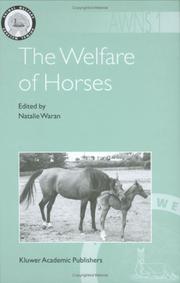
ISBN: 9781402007668 1402007663 9780306482151 1402061420 0306482150 1280957840 Year: 2002 Publisher: Dordrecht ; Boston : Kluwer Academic Publishers,
Abstract | Keywords | Export | Availability | Bookmark
 Loading...
Loading...Choose an application
- Reference Manager
- EndNote
- RefWorks (Direct export to RefWorks)
Animal welfare is attracting increasing interest worldwide, but particularly from those in developed countries, who now have the knowledge and resources to be able to offer the best management systems for their farm animals, as well as potentially being able to offer plentiful resources for companion, zoo and laboratory animals. The increased attention given to farm animal welfare in the West derives largely from the fact that the relentless pursuit of financial reward and efficiency has led to the development of intensive animal production systems, that challenge the conscience of many consumers in those countries. In developing countries human survival is still a daily uncertainty, so that provision for animal welfare has to be balanced against human welfare. Welfare is usually provided for only if it supports the output of the animal, be it food, work, clothing, sport or companionship. In reality, there are resources for all if they are properly husbanded in both developing and developed countries. The inequitable division of the world’s riches creates physical and psychological poverty for humans and animals alike in all sectors of the world. Livestock are the world’s biggest land user (FAO, 2002) and the population is increasing rapidly to meet the need of an expanding human population. Populations of farm animals managed by humans are therefore increasing worldwide, and there is the tendency to allocate fewer resources to each animal. Increased attention to welfare issues is just as evident for companion, laboratory, wild and zoo animals.
Horses. --- Animal welfare. --- Chevaux --- Animaux --- Protection --- Agriculture. --- Horses --- Animal welfare --- Recreation & Sports --- Zoology - General --- Zoology --- Social Sciences --- Health & Biological Sciences --- 633.5 --- Paarden (lt) --- Veterinary medicine --- Abuse of animals --- Animal cruelty --- Animals --- Animals, Cruelty to --- Animals, Protection of --- Animals, Treatment of --- Cruelty to animals --- Humane treatment of animals --- Kindness to animals --- Mistreatment of animals --- Neglect of animals --- Prevention of cruelty to animals --- Protection of animals --- Treatment of animals --- Welfare, Animal --- Equus caballus --- Farriery --- Hippology --- Horse --- Domestic animals --- Equus --- Livestock --- Pachyderms --- Hinnies --- Mules --- Abuse of --- Social aspects --- Zoology. --- Animal genetics. --- Animal physiology. --- Animal behavior. --- Animal Genetics and Genomics. --- Animal Physiology. --- Behavioral Sciences. --- Animals, Habits and behavior of --- Behavior, Animal --- Ethology --- Animal psychology --- Ethologists --- Psychology, Comparative --- Animal physiology --- Biology --- Anatomy --- Genetics --- Natural history --- Behavior --- Physiology --- Behavioral sciences.
Book
ISBN: 9781402057755 9400736789 1402035829 9786612824784 1282824783 140205775X Year: 2009 Publisher: Dordrecht : Springer Netherlands : Imprint: Springer,
Abstract | Keywords | Export | Availability | Bookmark
 Loading...
Loading...Choose an application
- Reference Manager
- EndNote
- RefWorks (Direct export to RefWorks)
Techniques and theory for processing otoliths from tropical marine fish have developed only recently due to an historic misconception that these organisms could not be aged. Otoliths are the most commonly used structures from which daily, seasonal or annual records of a fish’s environmental history are inferred, and are also used as indicators of migration patterns, home range, spatial distribution, stock structure and life history events. A large proportion of projects undertaken on tropical marine organisms involve removal and processing of calcified structures such as otoliths, statoliths or vertebrae to retrieve biological, biochemical or genetic information. Current techniques and principles have evolved rapidly and are under constant modification and these differ among laboratories, and more particularly among species and within life history stages. Tropical fish otoliths: Information for assessment, management and ecology is a comprehensive description of the current status of knowledge about otoliths in the tropics. This book has contributions from leading experts in the field, encompasing a tropical perspective on daily and annual ageing in fish and invertebrates, microchemistry, interpreting otolith microstructure and using it to back-calculate life history events, and includes a treatise on the significance of validating periodicity in otoliths.
Nature protection --- natuurbeheer --- Zoomorphology. Zooanatomy --- zoölogie --- morfologie --- Otoliths. --- Fishes --- Morphology. --- Wildlife management. --- Morphology (Animals). --- Fish & Wildlife Biology & Management. --- Animal Anatomy / Morphology / Histology. --- Animal morphology --- Animals --- Body form in animals --- Zoology --- Morphology --- Animal populations --- Game management --- Management, Game --- Management, Wildlife --- Plant populations --- Wildlife resources --- Natural resources --- Wildlife conservation --- Management --- Wildlife. --- Fish. --- Animal anatomy. --- Animal anatomy --- Biology --- Physiology --- Fish --- Pisces --- Aquatic animals --- Vertebrates --- Fisheries --- Fishing --- Ichthyology --- Anatomy
Book
ISBN: 9780387793825 038779381X 9780387793818 1441927212 9786611772734 1281772739 0387793828 Year: 2008 Publisher: New York, NY : Springer New York : Imprint: Springer,
Abstract | Keywords | Export | Availability | Bookmark
 Loading...
Loading...Choose an application
- Reference Manager
- EndNote
- RefWorks (Direct export to RefWorks)
Meat and meat products constitute some of the most important foods in western societies. However, the area of meat biotechnology is not as comprehensively covered as other areas of food biotechnology. Missing from this area are the recent developments for better sensory and nutritional quality as well as improved safety. The main goal of this book is to provide the reader with the recent developments in biotechnology and their applications in the meat processing chain. To achieve this goal, the book is divided into four parts. The first part deals with the use of modern biotechnology applied to farm animals. The second part focuses on the recent biotechnological developments in starter cultures for better meat fermentation. The third part discusses current approaches to improve the quality and nutritional properties of meats. The final part presents the latest advances in protection against foodborne pathogens, and other recent trends in the field. Written by distinguished international contributors, this book brings together the advances in such varied and different biotechnological topics.
Chemistry. --- Food Science. --- Chemistry/Food Science, general. --- Biotechnology. --- Food science. --- Chimie --- Biotechnologie --- Meat -- Microbiology. --- Meat -- Quality. --- Meat animals -- Genetic engineering. --- Meat animals --- Meat --- Biomedical Engineering --- Diet & Clinical Nutrition --- Microbiology & Immunology --- Health & Biological Sciences --- Biology --- Genetic engineering --- Quality --- Microbiology --- Genetic engineering. --- Quality. --- Microbiology. --- Meat quality --- Bacteriology --- Food --- Quality of products --- Food animals --- Chemical engineering --- Physical sciences --- Science --- Food—Biotechnology.
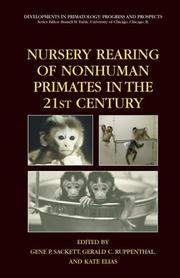
ISBN: 9780387256405 0387256326 9780387256320 9786612823251 0387256407 1282823256 Year: 2006 Publisher: New York : Springer,
Abstract | Keywords | Export | Availability | Bookmark
 Loading...
Loading...Choose an application
- Reference Manager
- EndNote
- RefWorks (Direct export to RefWorks)
Nursery Rearing of Nonhuman Primates in the 21st Century describes how and why nursery rearing of primates can produce adaptable juveniles and adults for research, conservation, and display-educational purposes. The volume details the history of nursery rearing since the mid-19th century, the outcomes of varied nursery rearing methods, the contemporary goals of nursery rearing as well as reference data derived from species commonly reared in nursery or hand-feeding situations. Examples of the changing goals of nursery rearing covered in this volume are the need for biological containment in disease research, the production of specific pathogen-free colonies by removal of neonates from the mother, the production of phenotypes for genetic and molecular biology studies, and the breeding of endangered species for conservation or research purposes.
Medicine & Public Health. --- Veterinary Medicine. --- Anthropology. --- Zoology. --- Behavioural Sciences. --- Medicine. --- Veterinary medicine. --- Animal behavior. --- Médecine --- Médecine vétérinaire --- Animaux --- Zoologie --- Anthropologie --- Moeurs et comportement --- Primates -- Nursery care. --- Primates as laboratory animals. --- Primates as laboratory animals --- Primates --- Animals, Laboratory --- Animal Husbandry --- Growth and Development --- Mammals --- Physiological Processes --- Agriculture --- Animal Population Groups --- Vertebrates --- Technology, Industry, and Agriculture --- Animals --- Physiological Phenomena --- Chordata --- Phenomena and Processes --- Eukaryota --- Technology, Industry, Agriculture --- Organisms --- Animal Sciences --- Veterinary Medicine --- Zoology --- Health & Biological Sciences --- Earth & Environmental Sciences --- Nursery care --- Nursery care. --- Nursery care of primates --- Nursery rearing of primates --- Behavioral sciences. --- Behavioral Sciences. --- Laboratory animals --- Infancy --- Breeding
Book
ISBN: 9781402061509 1402061501 9781402061523 9400786778 9786610955428 1280955422 1402061528 Year: 2007 Publisher: Dordrecht : Springer,
Abstract | Keywords | Export | Availability | Bookmark
 Loading...
Loading...Choose an application
- Reference Manager
- EndNote
- RefWorks (Direct export to RefWorks)
Plio-Pleistocene sites are a rare occurrence in the archaeological record. When they are uncovered, the faunal materials so crucial to unlocking their behavioral meaning are often poorly preserved. For example, at Koobi Fora, Kenya, a prolific region that preserves several classic Plio-Pleistocene sites, many bones are affected by poor cortical surface preservation (Isaac, 1997). Such taphonomic vagaries limit the range of questions that can be addressed with these assemblages. In other instances, access to materials can be limited due to local from politics or rivalries between individual research teams. As a result, many important assemblages either remain unstudied or have been interpreted without the advantage of a fully developed taphonomic framework, a situation that all but guarantees stagnant interpretations.
Fossil hominids --- Paleontology --- Paleoanthropology --- Animals, Fossil --- Homme fossile --- Paléontologie --- Paléoanthropologie --- Animaux fossiles --- Olduvai Gorge (Tanzania) --- Olduvai (Tanzanie) --- Antiquities. --- Antiquités --- EPUB-LIV-FT SPRINGER-B LIVSOCIA --- Anthropology. --- Archaeology. --- Geology. --- Paleontology . --- Paleontology. --- Fossilogy --- Fossilology --- Palaeontology --- Paleontology, Zoological --- Paleozoology --- Historical geology --- Zoology --- Fossils --- Prehistoric animals in motion pictures --- Geognosy --- Geoscience --- Earth sciences --- Natural history --- Archeology --- Anthropology --- Auxiliary sciences of history --- History --- Antiquities --- Human beings --- Paleolithic period, Lower --- Taphonomy --- Animal remains (Archaeology) --- Tanzania --- Animal fossils --- Animals, Antediluvian --- Animals, Prehistoric --- Antediluvian animals --- Fauna, Prehistoric --- Prehistoric animals --- Prehistoric fauna --- Ice Age --- Pleistocene Epoch --- Early man --- Fossil hominins --- Fossil man --- Hominids, Fossil --- Hominins, Fossil --- Human fossils --- Human remains (Archaeology) --- Primates, Fossil --- Human paleontology --- Anthropology, Prehistoric --- Physical anthropology --- Archaeozoology --- Zooarchaeology --- Zoology in archaeology --- Archaeology --- Bones --- Animal paleopathology --- Chopper-Chopping Tool Complex --- Lower Paleolithic period --- Stone age --- Methodology --- Olduwai Gorge (Tanzania)
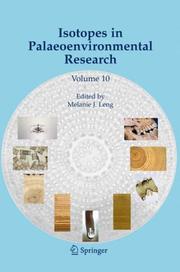
ISBN: 1402025033 9786610459315 128045931X 1402025041 9781402025037 9781402025044 Year: 2006 Volume: 10 Publisher: Dordrecht : Springer,
Abstract | Keywords | Export | Availability | Bookmark
 Loading...
Loading...Choose an application
- Reference Manager
- EndNote
- RefWorks (Direct export to RefWorks)
This volume is intended to show how stable isotopes can be applied to understanding the palaeoenvironment. There are chapters on the interpretation of isotopes in water, tree rings, bones and teeth, lake sediments, speleothems and marine sediments. Crucial to the understanding of the environmental signal contained within the isotope composition of different materials is to gain more information about how rainfall isotope compositions are determined by climate. Chapter 1 (Darling et al. ) describes O, H and C stable isotope compositions in the modern day water and aqueous carbon cycles to provide a framework for the interpretation of these isotopes in the past. The chapter on the water cycle divides naturally into a number of sections. The starting point, precipitation, is especially important because it is the precursor to which most O and H isotope proxy studies are attempting to relate. While much is understood about the isotope systematics of precipitation, largely owing to the existence of the IAEA– WMO Global Network for Isotopes in Precipitation (GNIP), important questions remain to be answered in relation to the isotope-temperature gradients of past climatic conditions. The chapter describes the three reservoirs of water sustaining all terrestrial proxies; soil and vadose zone moisture, groundwater, and surface waters. In each reservoir isotope effects intervene to modify to a greater or lesser extent the isotope signature of antecedent precipitation; groundwaters are least affected and surface waters the most.
Isotopes --- Paleontology --- Isotopes. --- Paleontology. --- Paléontologie --- EPUB-LIV-FT LIVTERRE SPRINGER-B --- Fossilogy --- Fossilology --- Palaeontology --- Paleontology, Zoological --- Paleozoology --- Historical geology --- Zoology --- Fossils --- Prehistoric animals in motion pictures --- Nuclides
| Listing 1 - 10 of 64 | << page >> |
Sort by
|

 Search
Search Feedback
Feedback About
About Help
Help News
News